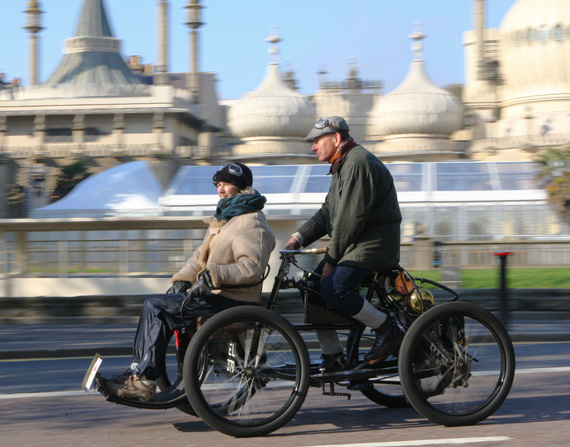
Brown Brother of London offered Tricycles and a light steam car. However as they did not have any manufactures premises, they offered the American Whitney as the Brown Whitney and also some cars made by Star. This Quadricycle, entered by Mr. David Oakley, hails from 1899 and is powered by a 2.25 cylinder engine.
Story and Photos by Jonathan Sharp
November 1st, 2015
The sun came out and it was lovely and warm in Brighton today. Not the usual weather for the London to Brighton Run. It is November but this year there was a blazing sun and I needed a sun blocker. My first memory of the event is watching the cars pass from the side windows of my father’s Austin 1300 whilst parked on the A23 just outside of Brighton; it was usually raining. Sunday the 1st November, 2015 will go down in the weather history books as being the hottest November day in Great Britain for 70 years.
But it was a good day for Brighton Run entrants, as virtually every car is open to the elements; it is much more fun to drive Veteran cars in good weather than rain or snow. Nevertheless, many of the entrants were ready for anything; when they left London at dawn it was very foggy and cold, The weather cleared mid morning and got rather warm!
This year the Run celebrated the 119th anniversary of the first run, making the event the longest running motoring event in the world. It takes place on the first Sunday of every November and commemorates the Emancipation Run of 14 November, 1896 which celebrated the passing into law of the Locomotives on the Highway Act, which raised the speed limit for ‘light locomotives’ from 4 mph to 14 mph and abolished the requirement for these vehicles to be preceded by a man on foot. The early law required the man on foot to carry a red flag but that requirement was abolished in 1878. The Locomotive Act was still widely known as the ‘Red Flag Act’ and a red flag was symbolically destroyed at the start of the Emancipation Run, as it is today just before the start in Hyde Park. This year the red flag was symbolically destroyed this year by BBC Radio DJs Chris Evans and Ken Bruce together with BBC TV One Show presenter Alex Jones and a few other sundry personalities.
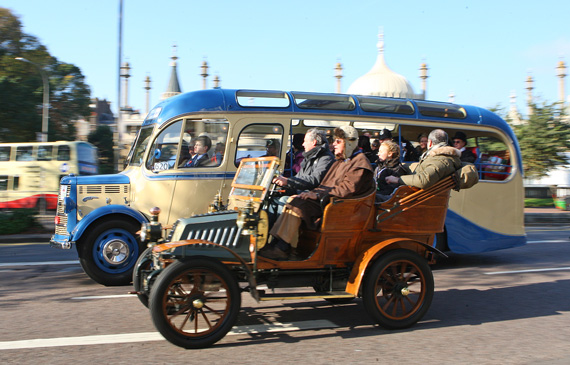
Here we see Mr. Michael Sapsford’s 1902 single cylinder 8 HP De Dion Bouton from 1902. The bus behind deserves further explanation. Chris Evans auctioned off a package where 5 generous bidders spent over £390k for themselves and 35 of their friends to be driven by BBC’s Chris Evans, Ken Bruce and Alex Jones, in three different 1950’s buses. The bus shown here is a Bedford and is being driven by Alex Jones.
Over 400 cars took part in the event, of which 342 made it to Maderia drive In Brighton before 4.30pm to qualify for a much prized finishers medal. The route length is 60 miles, most of which was lined with clapping spectators with the finishing line on the Brighton seafront being a very popular place to watch the arrivals. Every entrant that finished was clapped across the line by the crowd. But those that staggered across the line were greeted with hearty cheering. It was a joy to see the happiness on the faces of the drivers and passengers as they cross the line.

Entered by Mr. Ron Walker this 1901 Renault racing two-seater is powered by a 7.5 HP single cylinder engine.
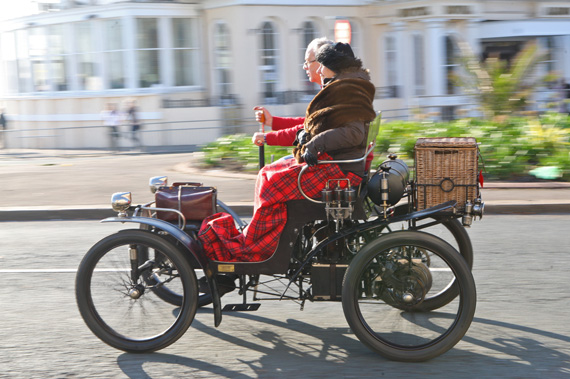
Mr. Xavier De Connick’s 1899 2 cylinder Decauville Vis a Vis. Decauvilles were made at Seine Et Otise in France. They produced a small car which was powered by two 1.75 HP De Dion engines on the same crankcase mounted under the seat.
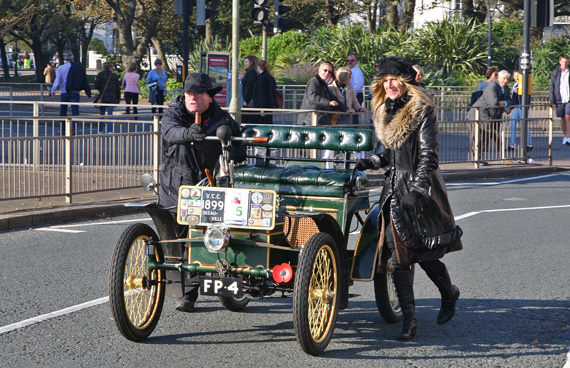
The 1899 3.5HP 2 cylinder Decauville Voiturette entered by Mr. Trevor Ellis and driven by Mr. Kevin Cox requires a little extra horsepower.
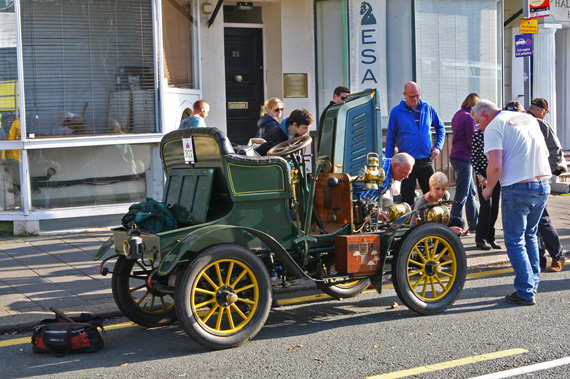
With less than a quarter of a mile to go to the finishing line, the 1904 6HP single cylinder De Dion Bouton comes to a halt. They got it going and crossed the line about 30 minutes later.

Anthony Pownall’s 1898 1.75 HP single cylinder De Dion Bouton Tricycle ridden by Mr. Stephen Dickson.
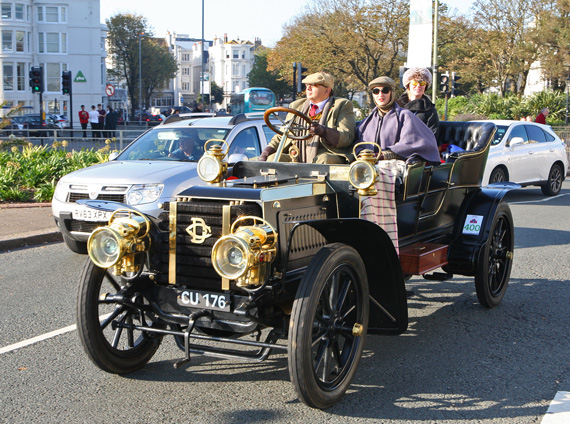
Mr. Daniel Ghose’s Delaugere et Clayette dates from 1904. Power comes from a 4 cylinder 24 HP engine. The company of Delaugere had been a long established family company of carriage and wagon makers when Maurice Clayette joined them in 1904. The founder of the company’s son and great nephew had built a three wheeled car in 1898 and a four wheeled example in 1900. This used a De Dion engine but by 1901 Delaugere were building their own two cylinder engines, and in 1902 four cylinder engines.
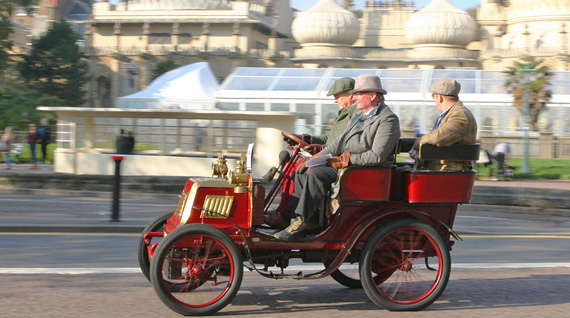
Mr. Tim Summer’s 1900 Darracq 6.5 HP single cylinder Voiturette. During the years 1895 and 1905 Darracq manufactured cars at Suresnes, Seine France. In 1900, having previously, but unsuccessfully, manufactured four wheeled Bolles under license, employed Paul Ribeyrolles as designer. Darracq quickly became the second largest car maker in France.
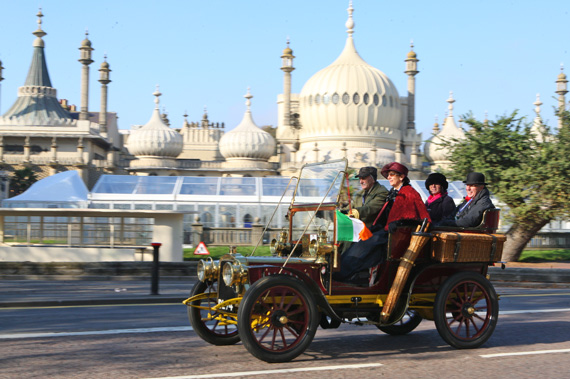
This 4 cylinder 14 HP Clement of Mr. Ivan Odds dates from 1903. Adolphe Clement started making cars in 1897 after many years of making bicycle components and pneumatic tires. By 1900 he was making the Clement Panhard car in his factory in Levallois France. Clement Talbots were made in London from 1902 and Clement Bayards were made in Mezieres in France from 1903.
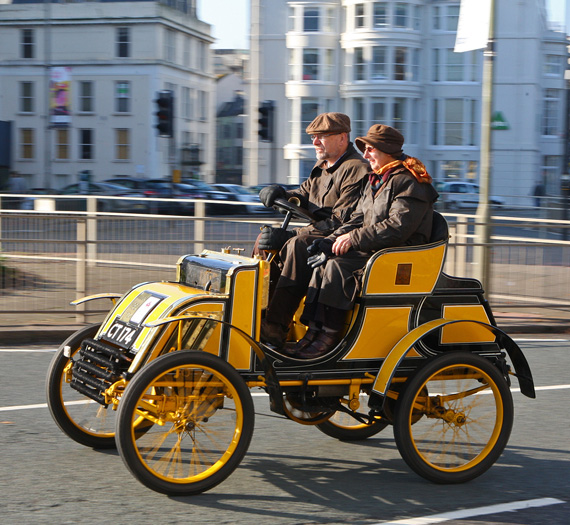
JH Pick originally made bicycles in Stamford Lincolnshire. They then made a couple of cars for the local gentry. From 1900 to 1904 they became the Pick Motor Company and made two De Dion-engined Voiturettes. This was followed by front-engined De Dion powered cars including 6 and 10 HP two cylinder engines. Production stopped in 1904 only to resume again in 1906. This example dates from 1901 and is listed as a single cylinder 4 HP model. Entered by Mr. Robert Hadfield.
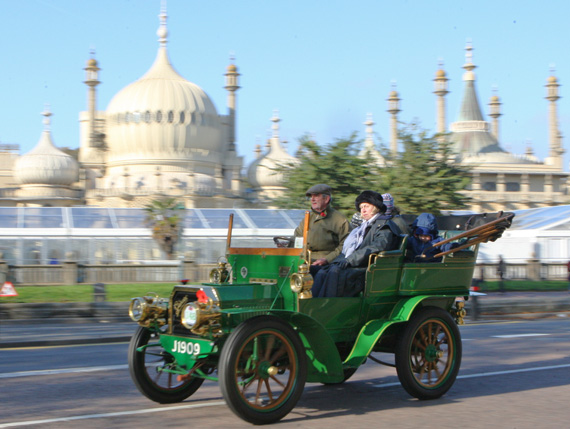
Paul Aucoq and Alexandre Darracq founded The Societe Gladiator Seine France to make bicycles at low cost. Harvey Du Cros and Ernest Hooley bought out Gladiator and added light cars to the range. These were fitted with single cylinder engines of 4 hp. By 1899 the engines had moved to the front of the car and were Adler units. By 1903 they were making 1000 cars a year, of which 80% were sold in Great Britain. This Gladiator entered and driven by Mr. Geoffrey Grime dates from 1902 and is powered by a 10 HP two cylinder engine.
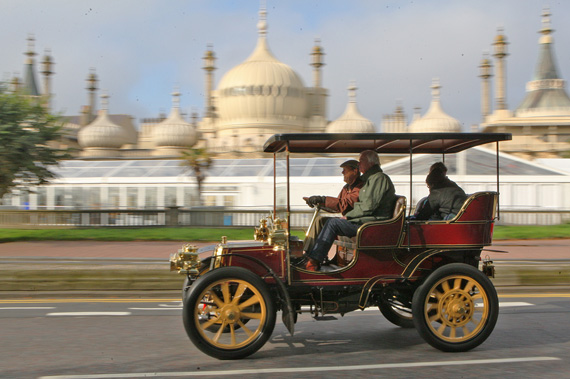
1903 Panhard. Rene Panhard had met Emile Levassor as a student and by 1872 they were working together. The factory in Paris produced four identical cars in 1891, 15 in 1892, 37 in 1893 and 41 in 1894. This qualifies them as being the first marque of car to be in continuous production. Dr. Terence Bramall’s example shown here dates from 1903 and is listed as having a four cylinder engine of 15 HP..
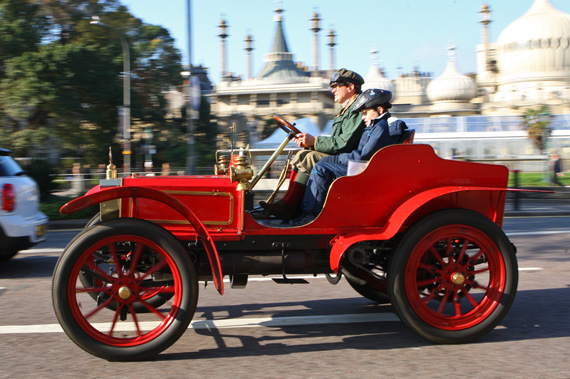
Entered by Earl Alexander Antrim and driven by Viscount Randall Dunluce this 4 cylinder 18 HP Martini dates from 1903. Based in Neuchatel in France the Martini company original made armaments and book binding machinery. Adolf Martini was interested in building motorcars set up a new factory and after a few prototypes started to make touring cars from 1903.
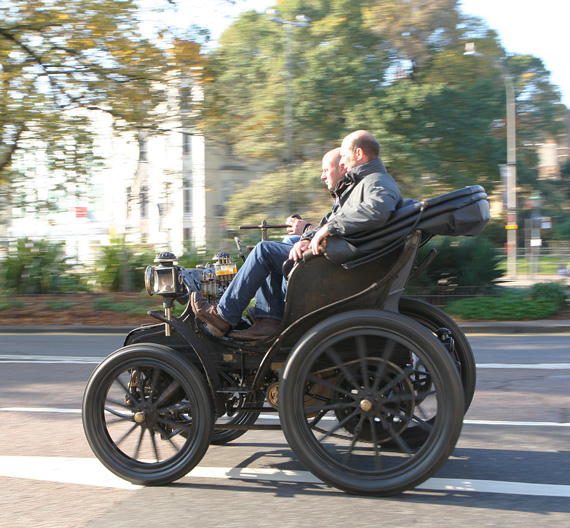
This is the sole surviving Henriod. This Swiss Henriod settled in Paris and started to build three-speed motor cars. Entered by Mr. Bernard Holmes and listed as driven by Messr’s Jonathan Wood and Dean Jaggard. It has 6 HP and 2 cylinders.
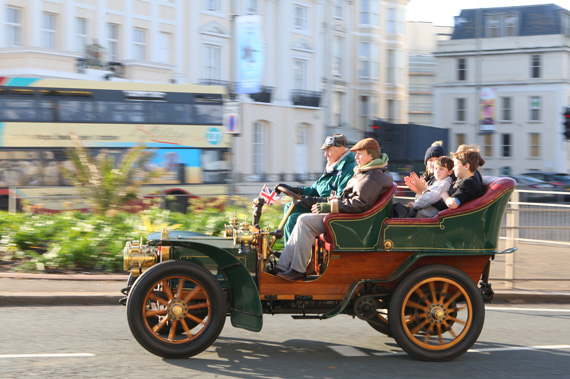
Dated as 1904 this swing seat Peugeot is powered by a 10 HP two cylinder engine. Entered and driven by Dr. Jeffrey Herbert.
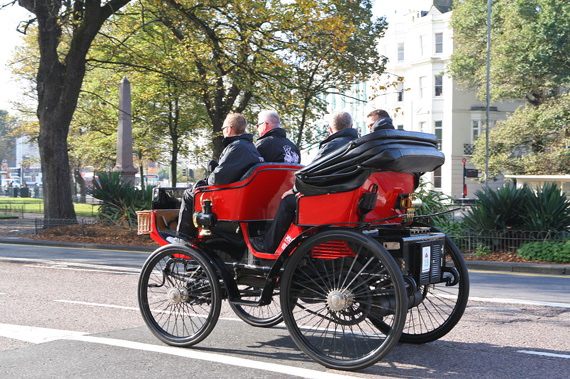
This Peugeot is much earlier. Dating from 1898 it is listed as a Double Phaeton power comes from a 6HP two cylinder engine. Entered and driven by Mr. Colin Clark.
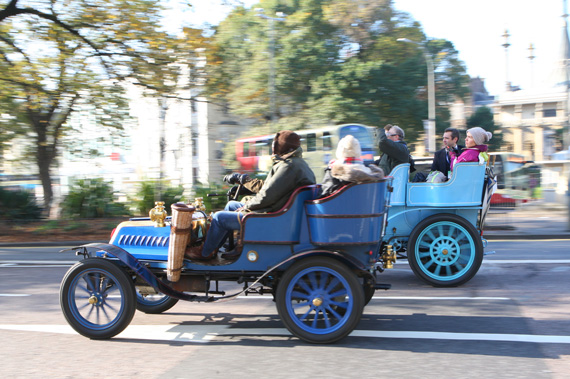
The Veteran car run is not a race but some cars are quicker than others. The car nearest is the 6HP single cylinder 1904 De Dion Bouton entered by Mr. Ian Johnstone and driven by Mr. Charles Ian Johnston. The car behind is a 1902 Panhard.
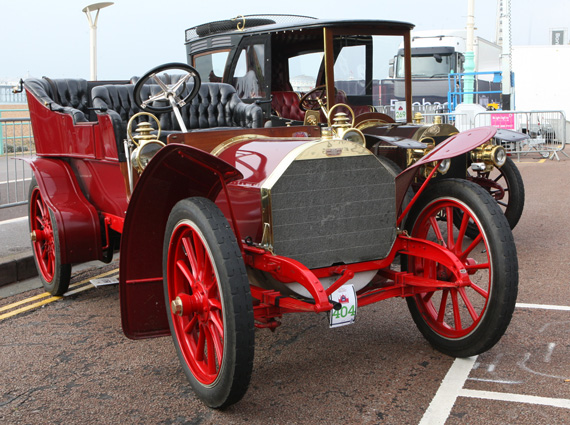
Car 404 is a 1904 40HP Fiat tonneau entered and driven by Mr. Jan Brujin from the Netherlands. The car parked next to it is the 1903 20 HP 4 cylinder closed swing seat tonneau Berliet entered by Mr. Arturo Keller and driven by Mr. CJ Bentley which finished first. These two were the first to the finishing line, neck and neck ages before any other cars arrived.
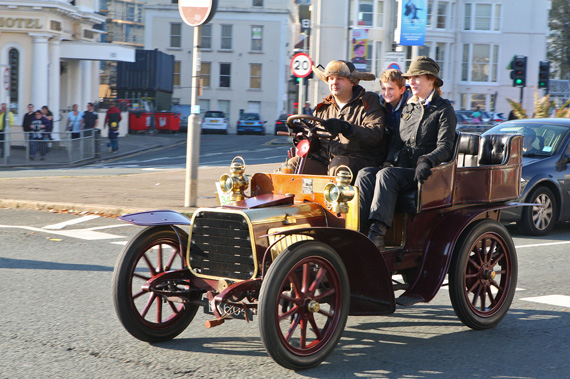

The Henriod brings to mind the modern Smart car.
Nothing is new really is it!